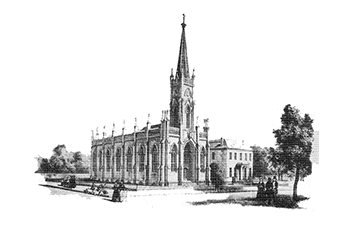
Recognized as an architectural masterpiece among Catholic churches in the south, it is today the spiritual home of a vibrant Catholic community who welcomes visitors from near and far away. The construction of this place of worship was begun in 1842 as a Cathedral in the newly established Diocese of Natchez, and St. Mary retained this status until 1977.
The Diocese of Jackson was divided into the dioceses of Jackson and Biloxi in 1977. The Jackson diocese (65 counties) consists of north, central, and southwest Mississippi, including Natchez. Since the transfer of the diocesan headquarters from Natchez to Jackson, the title of cathedral was transferred from St. Mary in Natchez to St. Peter the Apostle in Jackson.
Because our church is historically significant, Rome, in 1998, granted St. Mary the elevated status of minor basilica, an honor it now shares with 70 of the 250 dioceses in the United States.
There are two kinds of basilicas. The world’s four major basilicas—or papal basilicas—are in Rome, and minor basilicas—some in Rome and others elsewhere throughout the world—are given special ecclesiastical privileges by the Holy Father.
A basilica is expected “to be a center of active and pastoral liturgy” according to the 1989 Vatican document regarding the sacredness of worship space. In a minor basilica, all the liturgical roles for congregation members are to be promoted, liturgical music is to be prayerfully developed, and special feasts days and devotional practices are to be observed. The feast days include the feast of the chair of Peter on February 22, the solemnity of the apostles Peter and Paul on June 29, the World Day of the Sick on February 16, and election or inauguration anniversaries of the pope. The devotional practices include regular scheduling of reconciliation, frequent/regular times for adoration, Stations of the Cross, devotional practices honoring the Blessed Virgin Mary, and Lenten penitential practices.
Three symbols that indicate that a church is a basilica (St. Mary is a minor basilica). The first symbol is a umbraculum or conopaeum—a silk canopy or umbrella designed with stripes of yellow and red—traditional papal colors. The second symbol is the tintinnabulum, or bell. It is mounted on a pole and may be carried in processions. Both of these symbols are located in the altar area at St. Mary. The third symbol is the papal coat of arms which is installed on the left-hand side outside the main entrance to St. Mary Basilica.
St. Mary’s congregation takes pride not only in the Gothic Revival style of the Basilica but also its prayerful setting in the midst of colored carvings, painted ceiling, and ribbed vaulting. Natchez is the birthplace of Mississippi. It is a tourist destination because of its historic antebellum homes, and St. Mary Basilica—also antebellum—is the city’s central landmark.
St. Mary Basilica is spiritual home to about 2,000 Roman Catholics. It has provided Catholic education through the Cathedral School system since 1853. The school’s (K-12) enrollment at present is more than 600 students.
Mission of St. Mary Basilica
St. Mary Basilica Parish is a community of believers united by faith in Jesus Christ and committed to bringing about the kingdom of God. Parish members are encouraged to grow in faith through the celebration of the Eucharist and sacraments, by the study of the Sacred Scriptures and the Catholic Tradition, and by active participation in the ministries of the parish. Parish members are expected to be witnesses for their faith by loving support of one another and through service to the needy, the wider community, and the world mission of the Catholic Church.

